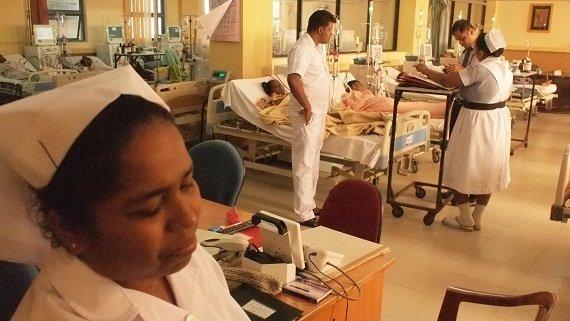CERITA
Kidney Disease Killing Thousands in Sri Lanka
"More than 20 000 farmers in Sri Lanka have lost their lives due to an unexplained kidney disease. Those affected are mainly rice farmers in the north. "
Ric Wasserman

More than 20 000 farmers in Sri Lanka have lost their lives due to an unexplained kidney disease. Those affected are mainly rice farmers in the north.
The kidney disease has now reached epidemic proportions. Clinics, overfilled with patients are cueing for the few dialysis machines available.
Karnu Jemanta and his brother who are working their rice field outside the village Rambewa are worried:
“We’re not sick yet, but we may be soon. People from the health ministry came and said it could be chemicals, or that we should drink more water when we’re working. We’re doing what they’ve told us to do,” he said.
In his small house near Rambewa village, 74 yr old Puntibanda is stretched out on his bed, in the last stage of kidney failure.
“Four of my farmer friends are in the same condition as me. We all drank water from the canals as well as directly from the fields, when we had to. The doctor said I’m dying of kidney failure, but he couldn’t say why,” he said.
When I arrive to the kidney unit at the provincial hospital in the the town of Anuradhapura it becomes clear that this is truly an epidemic. There are over a hundred people cued up for kidney examinations today.
The estimated number of those affected is 400,000 according to the Sri Lankan health ministry.
“I would say it was noticed some 15 to 20 years back. They looked into it in detail and found that there were lots of patients with kidney disease here,” explains Dr Rajeewa Dissanayake a nephrologist at the Anuradhapura Hospital kidney unit.
He says a screening program has helped find those affected:
“So far I think about 150 000 have been screened and a number of them have been detected and have been treated. So I think we’re doing ok. The only problem is that we don’t know what the cause is, so it’s difficult to prevent not knowing the cause.”
Over 20.000 have died and many more will follow-unless the cause is found.
Dr Channa Jajasumana at the medical faculty at Rajarata University says more research is needed. He’s been studying the kidney disease in Sri Lanka for the last 10 years and says there are two important questions to be answered:
“Why has this epidemic come after the mid 1990’s? The second question: what is the reason for this unique geographical distribution?”
Dr Jajasumana opens his computer screen to a map of Sri Lanka with the various kidney disease affected districts highlighted.
He points to a clear area where there is no disease.
“You will see that this disease is confined to certain regions of the dry zone in Sri Lanka, but not in the northern peninsula. There the climate is quite hot as compared to Anuradhapura- but no disease. What could be the reason? The reason is due to the terrorist problem for the last 30 years, the government of Sri Lanka did not allow to be sent any agrochemicals to the more northern area. The people in the northern area have not used those chemical because terrorists used these chemicals and fertilizers to produce explosives,” he argued.
Dr Jajusamanas epidemiological study points the finger at agrochemicals- but so far that hasn’t been substantiated with hard, empirical evidence.
One thing is certain: 80 percent of those affected are poor rice farmers.
The World Health Organisation released a study in 2013 regarding the Sri Lankan kidney epidemic which points to several possible causal factors: low levels of cadmium and other heavy metals, pesticides, dehydration and genetic factors.
Curiously, there is a similar, ongoing kidney epidemic in Latin America. Research being carried out by a Swedish team of researchers there led by kidney specialist Dr CG Elinder points to chronic dehydration.
In Latin America it’s sugar cane workers that are being affected.
“We’ve done specialized examinations on patients and we ’ve seen that their kidneys don’t have typical appearance as those affected by chemical. With inflammation. What we see is kidneys that are affected by the lack of oxygen. That can mean that they hare suffering from chronic dehydration and loss of electrolytes,” he said.
In the hot climate, cutting sugar cane all day and not drinking enough can cause chronic damage to the kidneys, says Dr Elinder.
But researchers don’t know if the underlying cause is the same in both Latin America and in Sri Lanka. In a few months the Swedish and Sri Lankan research teams will meet in the north of Sri Lanka to do further studies.
The kidney disease epidemic is not new-in fact it’s been known for over two decades.
In spite of the thousands of deaths on several continents it’s hard to find sufficient funding for research, says Dr Annika Werneson, a pathologist with the Swedish research team.
She’s frustrated that the disease is not given the attention it deserves from the more developed countries,
“If this epidemic had happened in Europe we’d certainly have found plenty of research money.”
- Kidney epidemic
- kidney disease Sri Lanka
- Ric Wasserman
- eng
- misterious kidney disease
Komentar (0)
KBR percaya pembaca situs ini adalah orang-orang yang cerdas dan terpelajar. Karena itu mari kita gunakan kata-kata yang santun di dalam kolom komentar ini. Kalimat yang sopan, menjauhi prasangka SARA (suku, agama, ras dan antargolongan), pasti akan lebih didengar. Yuk, kita praktikkan!